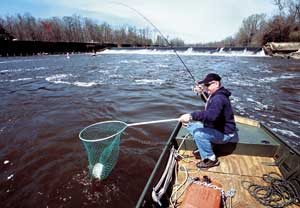
King’s Bluff lock and dam is top destination for blue cats at the state’s biggest river
Jackie Blanchard made a half-circle into the parking lot at the U.S. Army Corps of Engineers boating-and-picnic area at Lock and Dam No. 1 at King’s Bluff in Bladen County.
The dam is the first navigational hurdle in the Cape Fear River for humans and fish heading upriver from Wilmington. It’s a massive structure, built in the early 1900s.
The roar of the water cascading across the face of the dam is downright deafening. But the locks seldom operate for commercial traffic anymore. More often, they are used to elevate fish upstream of the obstacle.
Blanchard readied his gear then backed his trailer down the long, steep ramp to the water. Launching his boat, he would soon join other anglers fishing for shad, as his lightweight spinning tackle dangling tiny darts and jigs testified.
Yet curiosity would get the best of anyone checking out his other gear. The heavy ocean tackle resting on the seat alongside his ultra-light shad-spinning outfits seemed out of place, an indication he had bigger gamefish in mind.
Blanchard, a retired New Hanover County teacher, said he has fished for shad at the lock and dam since he was a teenager. However, last year he decided to fish for something new.
“I had heard of the big blue catfish being caught at the lock and dam,” he said. “Blue cats have really taken over the river, and they love to eat shad. So we thought we’d double our fun by fishing for shad and maybe catching a few blue cats at the same time.”
Blanchard and his pal, a fellow retired New Hanover County teacher, tied their boat off to the steel posts lining the west side of the river below the dam, jutting from the water just away from the side of the lock.
Blanchard uses wheelbarrow tires or boat tires as bumpers to protect his boat from the rusty metal as the boat sways in the churning current flow. He cuts holes in the tires to let the water out after fishing so they are lighter and don’t dump a deluge in the bottom of the boat when retrieved.
“When you get old like us, you don’t want to use a heavy cinder block as an anchor anymore,” he said. “It’s too heavy to retrieve and bangs up the boat. So we started tying off to the metal posts by the lock.
“But they keep moving the warning signs farther downstream each year so you might not be able to tie up that close to the dam some day.
“You really want to heed those warning signs and stay away from the dam.”
People have been drowned and boats have been sunk when they ventured too near the dam.
The water creates a whirlpool affect that can draw boats upstream beneath the cascading water and sink them in a flash so boaters must keep a safe distance.
“The other potential hazard is the overhanging trees,” Blanchard said. “I’ve never seen one fall from the dam. But every time you go up there, there is at least one big old tree stuck across the top of the dam. Sooner or later, it’s going to float across.
“If you happened to be anchored downstream of the tree, it would be a mighty dangerous situation. The tree could sink your boat.”
Blanchard and his pals, Gaither Lewis and Alex Sneed, have caught catfish weighing as much as 35 pounds at Lock and Dam No. 1.
They prefer to use the freshest shad they can as catfish bait, preferring to catch a buck American, also known as the white shad, by slicing it into strips. They usually let the larger roe shad go. Roe shad can weigh 8 pounds while buck shad weigh a couple of pounds.
“I might use a shad I’ve caught the day before,” Blanchard said. “The limit is 10 shad, but I’m the only one in my family who eats them. So I keep a couple to fry and use the others for bait or let them go.
The rest of this story, which first appeared in the March 2007 issue of North Carolina Sportsman, can be found in the online archives.
Be sure to subscribe to the magazine to ensure you don’t miss a single issue, which will be delivered right to your door.





Be the first to comment